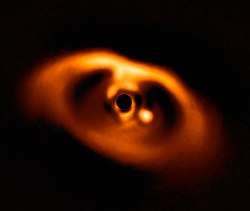Mini-Neptune
A mini-Neptune (sometimes known as a gas dwarf or transitional planet) is a planet less massive than Neptune but resembles Neptune in that it has a thick hydrogen–helium atmosphere, probably with deep layers of ice, rock or liquid oceans (made of water, ammonia, a mixture of both, or heavier volatiles).[1]
A gas dwarf is a gas planet with a rocky core that has accumulated a thick envelope of hydrogen, helium, and other volatiles, having as result a total radius between 1.7 and 3.9 Earth radii (1.7–3.9 R⊕). The term is used in a three-tier, metallicity-based classification regime for short-period exoplanets, which also includes the rocky, terrestrial-like planets with less than 1.7 R⊕ and planets greater than 3.9 R⊕, namely ice giants and gas giants.[2]
Properties
Theoretical studies of such planets are loosely based on knowledge about Uranus and Neptune. Without a thick atmosphere, it would be classified as an ocean planet instead.[3] An estimated dividing line between a rocky planet and a gaseous planet is around 1.6-2.0 Earth radii.[4][5] Planets with larger radii and measured masses are mostly low-density and require an extended atmosphere to simultaneously explain their masses and radii, and observations are showing that planets larger than approximately 1.6 Earth-radius (and more massive than approximately 6 Earth-masses) contain significant amounts of volatiles or H–He gas, likely acquired during formation.[6][1] Such planets appear to have a diversity of compositions that is not well-explained by a single mass–radius relation as that found for denser, rocky planets.[7][8][9] Similar results are confirmed by other studies.[10][11][12] As for mass, the lower limit can vary widely for different planets depending on their compositions; the dividing mass can vary from as low as one to as high as 20 M⊕.
Smaller gas planets and planets closer to their star will lose atmospheric mass more quickly via hydrodynamic escape than larger planets and planets farther out.[13][14]
A low-mass gas planet can still have a radius resembling that of a gas giant if it has the right temperature.[15]
Neptune like planets are considerably rarer than sub-Neptunes, despite being only slightly bigger.[16][17] This “radius cliff” separates sub-Neptunes (radii < 3 Earth radii) from Neptunes (radii > 3 Earth radii).[16] This radius-cliff is thought to arise because during formation when gas is accreting, the atmospheres of planets that size reach the pressures required to force the hydrogen into the magma ocean stalling radius growth. Then, once the magma ocean saturates, radius growth can continue. However, planets that have enough gas to reach saturation are much rarer, because they require much more gas.[16]
Examples
The smallest known extrasolar planet that might be a gas dwarf is Kepler-138d, which is less massive than Earth but has a 60% larger volume and therefore has a density (2.1(+2.2/-1.2) grams per cubic centimetre) that indicates either a substantial water content[18] or possibly a thick gas envelope.[19]
See also
References
- D'Angelo, G.; Bodenheimer, P. (2016). "In Situ and Ex Situ Formation Models of Kepler 11 Planets". The Astrophysical Journal. 828 (1): id. 33. arXiv:1606.08088. Bibcode:2016ApJ...828...33D. doi:10.3847/0004-637X/828/1/33.
- Three regimes of extrasolar planets inferred from host star metallicities, Buchhave et al.
- Optical to near-infrared transit observations of super-Earth GJ1214b: water-world or mini-Neptune?, E.J.W. de Mooij (1), M. Brogi (1), R.J. de Kok (2), J. Koppenhoefer (3,4), S.V. Nefs (1), I.A.G. Snellen (1), J. Greiner (4), J. Hanse (1), R.C. Heinsbroek (1), C.H. Lee (3), P.P. van der Werf (1),
- Architecture of Kepler's Multi-transiting Systems: II. New investigations with twice as many candidates, Daniel C. Fabrycky, Jack J. Lissauer, Darin Ragozzine, Jason F. Rowe, Eric Agol, Thomas Barclay, Natalie Batalha, William Borucki, David R. Ciardi, Eric B. Ford, John C. Geary, Matthew J. Holman, Jon M. Jenkins, Jie Li, Robert C. Morehead, Avi Shporer, Jeffrey C. Smith, Jason H. Steffen, Martin Still
- When Does an Exoplanet's Surface Become Earth-Like?, blogs.scientificamerican.com, 20 June 2012
- D'Angelo, G.; Bodenheimer, P. (2013). "Three-Dimensional Radiation-Hydrodynamics Calculations of the Envelopes of Young Planets Embedded in Protoplanetary Disks". The Astrophysical Journal. 778 (1): 77 (29 pp.). arXiv:1310.2211. Bibcode:2013ApJ...778...77D. doi:10.1088/0004-637X/778/1/77.
- Benjamin J. Fulton et al. "The California-Kepler Survey. III. A Gap in the Radius Distribution of Small Planets
- Courtney D. Dressing et al. "The Mass of Kepler-93b and The Composition of Terrestrial Planets"
- Leslie A. Rogers "Most 1.6 Earth-Radius Planets are not Rocky"
- Lauren M. Weiss, and Geoffrey W. Marcy. "The mass-radius relation for 65 exoplanets smaller than 4 Earth radii"
- Geoffrey W. Marcy, Lauren M. Weiss, Erik A. Petigura, Howard Isaacson, Andrew W. Howard and Lars A. Buchhave. "Occurrence and core-envelope structure of 1-4x Earth-size planets around Sun-like stars"
- Geoffrey W. Marcy et al. "Masses, Radii, and Orbits of Small Kepler Planets: The Transition from Gaseous to Rocky Planets"
- Feng Tian; Toon, Owen B.; Pavlov, Alexander A.; De Sterck, H. (March 10, 2005). "Transonic hydrodynamic escape of hydrogen from extrasolar planetary atmospheres". The Astrophysical Journal. 621 (2): 1049–1060. Bibcode:2005ApJ...621.1049T. CiteSeerX 10.1.1.122.9085. doi:10.1086/427204.
- Mass-radius relationships for exoplanets, Damian C. Swift, Jon Eggert, Damien G. Hicks, Sebastien Hamel, Kyle Caspersen, Eric Schwegler, and Gilbert W. Collins
-
- Mass-Radius Relationships for Very Low Mass Gaseous Planets, Konstantin Batygin, David J. Stevenson, 18 Apr 2013
- https://astrobites.org/2019/12/17/why-are-there-so-many-sub-neptune-exoplanets/
- Superabundance of Exoplanet Sub-Neptunes Explained by Fugacity Crisis, Edwin S. Kite, Bruce Fegley Jr., Laura Schaefer, Eric B. Ford, 5 Dec 2019
- Jontof-Hutter, D; Rowe, J; et al. (18 June 2015). "Mass of the Mars-sized Exoplanet Kepler-138b from Transit Timing". Nature. 522 (7556): 321–323. arXiv:1506.07067. Bibcode:2015Natur.522..321J. doi:10.1038/nature14494. PMID 26085271.
- Earth-mass exoplanet is no Earth twin – Gaseous planet challenges assumption that Earth-mass planets should be rocky
Further reading
- Six New Planets: Mini-Neptunes Found Around Sunlike Star, Victoria Jaggard, National Geographic News, Published February 2, 2011
- Barnes, Rory; Jackson, Brian; Raymond, Sean N.; West, Andrew A.; Greenberg, Richard (January 13, 2009). "The HD 40307 Planetary System: Super-Earths or Mini-Neptunes?". The Astrophysical Journal. 695 (2): 1006–1011. arXiv:0901.1698. Bibcode:2009ApJ...695.1006B. doi:10.1088/0004-637X/695/2/1006.
